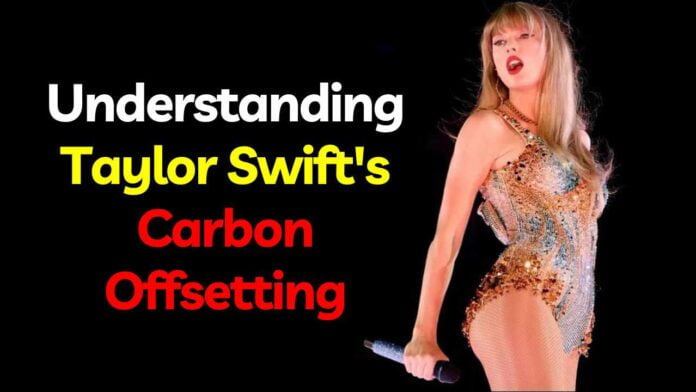Taylor Swift’s recent travel habits have sparked discussions about carbon emissions and sustainability. Despite criticism for her frequent private jet usage, Swift claims to offset her carbon footprint by purchasing carbon credits. But how does this process work, and is it effective in making air travel more sustainable?
Taylor Swift Criticism and Concerns

Taylor Swift’s private jet flights have drawn criticism for their significant carbon emissions. Critics argue that air travel, especially via private jets, contributes to climate change by releasing carbon dioxide into the atmosphere. This has raised concerns about the environmental impact of celebrity travel habits.
Carbon Offsetting Explained:
Carbon offsetting involves purchasing carbon credits to compensate for greenhouse gas emissions produced through activities like air travel. These credits support environmental projects that reduce or capture carbon dioxide, such as tree-planting initiatives. Swift claims to have bought double the amount of carbon offsets needed for her Eras Tour, potentially covering her additional travel for personal reasons.
Effectiveness of Carbon Offsets:

While carbon offsets can counteract emissions, their effectiveness varies. Some projects, like tree planting, can effectively capture carbon from the atmosphere. However, there are concerns about the accuracy of offset calculations and the long-term impact of these projects. Critics argue that carbon offsets may not effectively reduce overall emissions and could be seen as a way to justify unsustainable behavior.
Alternative Sustainability Measures:
View this post on Instagram
In addition to carbon offsets, there are other ways to minimize carbon footprints while traveling. Artists like Coldplay and Billie Eilish prioritize sustainability on their tours by reducing single-use plastics and implementing eco-friendly practices. Individuals can also reduce their carbon footprint by choosing eco-friendly transportation options, minimizing meat consumption, and supporting sustainable tourism initiatives.
Room for Improvement:

While carbon offsets may mitigate some environmental impact, they are not a perfect solution. Taylor Swift’s critics argue that she could do more to promote sustainability, such as actively advocating for environmental causes or implementing greener practices in her tours. Ultimately, the effectiveness of carbon offsetting depends on the transparency and credibility of the projects supported.
10 Best Taylor Swift Songs of All Time
Taylor Swift has undoubtedly left an indelible mark on the music industry with her captivating melodies and poignant lyrics. From her country roots to her reign as the queen of pop, Swift’s discography boasts an array of timeless classics that have resonated with audiences worldwide. In this article, we’ll explore the top 10 best Taylor Swift songs of all time, celebrating the artistry and impact of this iconic musician.
1. “We Are Never Ever Getting Back Together”
- Released in 2012 as the lead single from her album “Red,” this catchy anthem captures the essence of moving on from a failed relationship with empowerment and wit.
2. “You Belong With Me”
- A fan favorite from her album “Fearless” released in 2009, this song beautifully portrays the longing and innocence of unrequited love.
3. “Shake It Off”
- As the lead single from her album “1989” in 2014, this exuberant track encourages listeners to embrace their individuality and brush off negativity with confidence.
4. “Blank Space”
- Delving into themes of love and perception, this 2014 single from “1989” offers a satirical take on Swift’s public image, showcasing her storytelling prowess.
5. “Style”
- With its pulsating beat and dreamy atmosphere, this 2015 single from “1989” immerses listeners in the intoxicating whirlwind of a passionate romance.
6. “Willow”
- Released in 2020 as the lead single from her album “Evermore,” this enchanting track explores the magic of love’s enchanting journey and the magnetic pull of destiny.
7. “Look What You Made Me Do”
- A departure from her usual sound, this bold single from her album “Reputation” in 2017 serves as a defiant response to controversies and criticisms.
8. “Love Story”
- Originally released in 2008 as the lead single from “Fearless,” this timeless anthem of romance and fairy-tale endings continues to resonate across generations.
9. “Bad Blood” (ft. Kendrick Lamar)
- Showcasing Swift’s versatility, this edgy collaboration from “1989” in 2015 delves into themes of betrayal and female empowerment.
10. “Wildest Dreams”
- With its dreamy melody and haunting imagery, this single from “1989” in 2015 transports listeners to a world of cinematic romance and nostalgia.
Whether you’re a longtime Swiftie or new to her music, these songs showcase the breadth and depth of Taylor Swift’s artistry. Each track captures the essence of love, heartache, and self-discovery with honesty and vulnerability, solidifying Swift’s legacy as one of the greatest songwriters of our generation.
Conclusion: Taylor Swift’s use of carbon offsets highlights the complexities of balancing celebrity lifestyles with environmental responsibility. While offsets can help mitigate emissions from air travel, they are just one part of a broader sustainability strategy. As discussions about climate change and individual responsibility continue, it’s essential to explore diverse approaches to reducing carbon footprints and promoting environmental stewardship.


